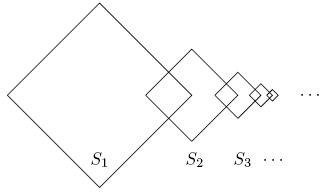Difference between revisions of "1995 AIME Problems/Problem 1"
(solution, box) |
|||
| (3 intermediate revisions by 2 users not shown) | |||
| Line 1: | Line 1: | ||
== Problem == | == Problem == | ||
| − | Square <math> | + | Square <math>S_{1}</math> is <math>1\times 1.</math> For <math>i\ge 1,</math> the lengths of the sides of square <math>S_{i+1}</math> are half the lengths of the sides of square <math>S_{i},</math> two adjacent sides of square <math>S_{i}</math> are perpendicular bisectors of two adjacent sides of square <math>S_{i+1},</math> and the other two sides of square <math>S_{i+1},</math> are the perpendicular bisectors of two adjacent sides of square <math>S_{i+2}.</math> The total area enclosed by at least one of <math>S_{1}, S_{2}, S_{3}, S_{4}, S_{5}</math> can be written in the form <math>m/n,</math> where <math>m</math> and <math>n</math> are relatively prime positive integers. Find <math>m-n.</math> |
[[Image:AIME 1995 Problem 1.png]] | [[Image:AIME 1995 Problem 1.png]] | ||
== Solution == | == Solution == | ||
| − | The sum of the areas of the [[square]]s if they were not interconnected is a [[geometric sequence]]: | + | The sum of the areas of the [[square]]s if they were not interconnected is a [[geometric sequence]]: |
| − | Alternatively, take the area of the first square and add <math>\frac{3}{4}</math> of the areas of the remaining squares. This results in <math>1 + \frac{3}{4}(\frac{1}{2}^2 + \ | + | :<math>1^2 + \left(\frac{1}{2}\right)^2 + \left(\frac{1}{4}\right)^2 + \left(\frac{1}{8}\right)^2 + \left(\frac{1}{16}\right)^2</math> |
| + | |||
| + | Then subtract the areas of the intersections, which is <math>\left(\frac{1}{4}\right)^2 + \ldots + \left(\frac{1}{32}\right)^2</math>: | ||
| + | |||
| + | :<math>1^2 + \left(\frac{1}{2}\right)^2 + \left(\frac{1}{4}\right)^2 + \left(\frac{1}{8}\right)^2 + \left(\frac{1}{16}\right)^2 - \left[\left(\frac{1}{4}\right)^2 + \left(\frac{1}{8}\right)^2 + \left(\frac{1}{16}\right)^2 + \left(\frac{1}{32}\right)^2\right]</math> | ||
| + | :<math>= 1 + \frac{1}{2}^2 - \frac{1}{32}^2</math> | ||
| + | |||
| + | The majority of the terms cancel, leaving <math>1 + \frac{1}{4} - \frac{1}{1024}</math>, which simplifies down to <math>\frac{1024 + \left(256 - 1\right)}{1024}</math>. Thus, <math>m-n = \boxed{255}</math>. | ||
| + | |||
| + | Alternatively, take the area of the first square and add <math>\,\frac{3}{4}</math> of the areas of the remaining squares. This results in <math>1+ \frac{3}{4}\left[\left(\frac{1}{2}\right)^2 + \ldots + \left(\frac{1}{16}^2\right)\right]</math>, which when simplified will produce the same answer. | ||
== See also == | == See also == | ||
| − | + | {{AIME box|year=1995|before=First Question|num-a=2}} | |
| − | {{ | + | [[Category:Introductory Geometry Problems]] |
| + | {{MAA Notice}} | ||
Latest revision as of 18:29, 4 July 2013
Problem
Square ![]() is
is ![]() For
For ![]() the lengths of the sides of square
the lengths of the sides of square ![]() are half the lengths of the sides of square
are half the lengths of the sides of square ![]() two adjacent sides of square
two adjacent sides of square ![]() are perpendicular bisectors of two adjacent sides of square
are perpendicular bisectors of two adjacent sides of square ![]() and the other two sides of square
and the other two sides of square ![]() are the perpendicular bisectors of two adjacent sides of square
are the perpendicular bisectors of two adjacent sides of square ![]() The total area enclosed by at least one of
The total area enclosed by at least one of ![]() can be written in the form
can be written in the form ![]() where
where ![]() and
and ![]() are relatively prime positive integers. Find
are relatively prime positive integers. Find ![]()
Solution
The sum of the areas of the squares if they were not interconnected is a geometric sequence:
Then subtract the areas of the intersections, which is ![]() :
:
The majority of the terms cancel, leaving ![]() , which simplifies down to
, which simplifies down to ![]() . Thus,
. Thus, ![]() .
.
Alternatively, take the area of the first square and add ![]() of the areas of the remaining squares. This results in
of the areas of the remaining squares. This results in ![$1+ \frac{3}{4}\left[\left(\frac{1}{2}\right)^2 + \ldots + \left(\frac{1}{16}^2\right)\right]$](http://latex.artofproblemsolving.com/f/1/a/f1ad25f7cc94b2582dca91b9ebdd23b3bec63068.png) , which when simplified will produce the same answer.
, which when simplified will produce the same answer.
See also
| 1995 AIME (Problems • Answer Key • Resources) | ||
| Preceded by First Question |
Followed by Problem 2 | |
| 1 • 2 • 3 • 4 • 5 • 6 • 7 • 8 • 9 • 10 • 11 • 12 • 13 • 14 • 15 | ||
| All AIME Problems and Solutions | ||
The problems on this page are copyrighted by the Mathematical Association of America's American Mathematics Competitions. 






![$1^2 + \left(\frac{1}{2}\right)^2 + \left(\frac{1}{4}\right)^2 + \left(\frac{1}{8}\right)^2 + \left(\frac{1}{16}\right)^2 - \left[\left(\frac{1}{4}\right)^2 + \left(\frac{1}{8}\right)^2 + \left(\frac{1}{16}\right)^2 + \left(\frac{1}{32}\right)^2\right]$](http://latex.artofproblemsolving.com/6/0/9/609fafb8171705bc071b28b2302550e4282c0eab.png)




